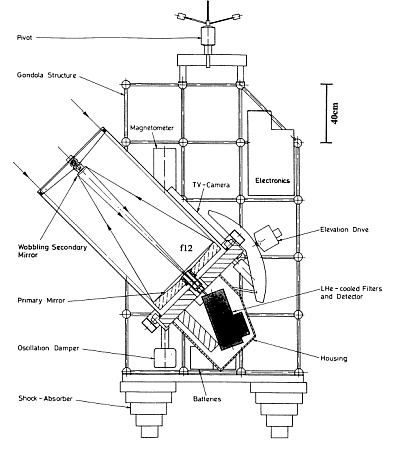Purpose of the flight and payload description
The instrument was composed by a 60 cm far-infrared balloon-borne telescope with attached photometer. A schematic of the complete system is shown at left. The Cassegrain-type telescope with a diffraction limited field of view was previously used in other experiments by the same group for the determination of temperature increases over active regions on the solar disk. For the goal of this mission which was the observation of molecular clouds in the galactic plane, was constructed a completely new instrument because of the higher sensitivity required.
The gondola structure and the telescope stabilization have been designed at the Geneva Observatory. A light-weight telescope frame with a honeycomb instrumental platform and a carbon reinforced plastic telescope tube has been developed at ETH-Zurich in order to reduce the weight of the instrumentation without loss of mechanical stiffness. The fully equipped gondola weighed 470 kg. Its dimensions were 120 cm in length, 170 cm in width and 250 cm in height. Telescope and instruments were protected during ascent and landing with doors and the whole gondola was wrapped in a insulating plastic skin. Coarse pointing with an accuracy of 2 arc min in azimuth was achieved by a magnetometer-controlled pivot, mounted between the gondola and the balloon. An inclinometer provided the coarse position in elevation. Once coarse pointing was accomplished, the star used as guide appeared in the 3° field viewed by a TV camera. The centering on the TV screen bringed the guidance star into the field of view of a star-tracker telescope and finally into its focus under automatic tracking control by a four quadrant fiber-optic and image disector. Reaction wheels whose rotating axes are parallel to the two telescope axes in combination with three gyros prevent the swinging of the gondola during the servo-controlled positioning of the telescope.
The far-infrared section of the gondola consisted of a Cassegrain-type telescope with an attached photometer. The telescope hads f/12 optics. The diameter of the primary mirror was 60 cm, that of the secondary mirror was 8.93 cm. The primary and secondary mirrors were fabricated of gold-coated solid Zerodur.
Beside the telescope, the optical system comprised helium-cooled bandpass filters and a cooled detector. Three mesh interference bandpass filters at a waveleghts of 80, 125 and 330 micrometers, were used alternatively. As detector was selected a composite silicon bolometer cooled to about 2 degrees Kelvin coupled to a cooled preamplifier and a phase sensitive amplifier outside the cryostat. The digitized detector signal together with housekeeping data were transmitted by telemetry to the ground station.
Details of the balloon flight
Balloon launched on: 5/12/1992 at 19:33 utc
Launch site: Centre de Lancement de Ballons CLBA, Aire Sur L'Adour, Landes, France
Balloon launched by: Centre National d'Etudes Spatiales (CNES)
Balloon manufacturer/size/composition: Zero Pressure Balloon Zodiac - 380.000 m3
End of flight (L for landing time, W for last contact, otherwise termination time): 5/13/1992 at 5:16 utc
Balloon flight duration (F: time at float only, otherwise total flight time in d:days / h:hours or m:minutes - ): ~ 12 h
Landing site: 40 km SE from Bordeaux, France
The balloon flight denominated Cygnus III was performed on the night of May 12/13, 1992. A 380.000 m3 stratospheric hydrogen balloon was used and the mission took place at Aire sur l'Adour, France. Launching took place by auxiliary balloon method at 19:33 UTC. After 2 1/2 hours of ascent the balloon reached his final altitude of about 39 km corresponding to an atmospheric pressure of 3.4 mbar at 22:00 UTC. Since the weather conditions were excellent, observations were performed during 5 hours. At 03:00 UTC the telescope was stowed in vertical position to permit separation of the gondola from the balloon. After passing over the critical area of Bordeaux, the gondola was separated from the balloon at 4:16 UTC and descended on three parachutes. It was recovered in the valley of the Garonne, about 40 km south-east from Bordeaux and about 80 km north of the launching site. Because of favourable conditions at the landing site no damage to the instruments and only slight deformation of the gondola structure occurred.
External references
- Balloon-borne imaging of the Cygnus-X region at 260 µm wavelength Infrared Physics & Technology, Vol.35, Issues 2-3 (1994), Pag. 221
16154If you consider this website interesting or useful, you can help me to keep it up and running with a small donation to cover the operational costs. Just the equivalent of the price of a cup of coffee helps a lot.


